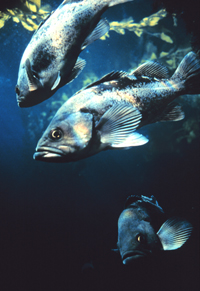NOAA Considers Case to Protect Five Puget Sound Rockfish Species
March 12, 2008

Black rockfish.
+ High Resolution (Credit: NOAA)
NOAA’s Fisheries Service is assembling a team of biologists to examine the decline of five Rockfish specifies in the Puget Sound and determine if it should formally propose listings under the Endangered Species Act. The assessment follows the acceptance of a petition filed by a Washington citizen.
There is evidence that the bocaccio, canary rockfish, yelloweye rockfish, greenstripe rockfish and redstripe rockfish species are much reduced from historical levels. Harvests during the 1970s and 1980s reduced stocks to very low levels. But, the fisheries agency added, there is little information regarding their present abundance. Although these rockfishes once were sought as sportfish, they are now occasionally caught only accidentally in fish harvests directed at other species.
A formal proposal by NOAA’s Fisheries Service – to be completed as early as fall would be followed by a year-long period of peer review, public comment and public hearings before any final decision about an official listing could be made.
Sam Wright, a retired biologist from Olympia, Wash, petitioned NOAA last April to list the five species under the ESA. At that time, NOAA could not tell if the petition described a genuine population declines because it lacked the information necessary to interpret the limited data it had been provided.
Last October, Wright provided additional information on fishing efforts and other factors. Today’s action is a result of the agency’s reconsideration of the April petition and the supplementary information provided.
The National Oceanic and Atmospheric Administration, an agency of the U.S. Commerce Department, is dedicated to enhancing economic security and national safety through the prediction and research of weather and climate-related events and information service delivery for transportation, and by providing environmental stewardship of our nation’s coastal and marine resources. Through the emerging Global Earth Observation System of Systems (GEOSS), NOAA is working with its federal partners, more than 70 countries and the European Commission to develop a global monitoring network that is as integrated as the planet it observes, predicts and protects.
